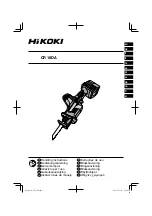
40
Adjusting the cutting angle (see Picture C)
After loosening the screw (25), the bottom plate (7) can be moved forward and backward, and inclined
leftward and rightward into desired angle according to scale (27). The angle reading is indicated in the U-
shaped window of the pressing block (24) on the bottom plate. The bottom plate is set to 0°angle from
the factory.
•
Before adjusting the cutting angle, remove the protective cover (26).
•
Loosen the tightening screw (25) with the allen key (17) far enough so that the saw foot (7) can be
easily turned.
•
Set the saw foot to the desired position 15°/30°/45° on the angle scale (27) and retighten the screw.
Straight cut (see Picture E)
When using the jigsaw to perform straight cuts, remember to attach the cover (21), plastic guide (22)
and plastic sliding shoe (27) too. The plastic guide limits the material’s fringe when the guide is inserted
between the base plate (7) and the sliding shoe (26) at the location of blade opening. The guide sits in
the opening with its raised side facing downwards to the worked surface and with flat side facing
upwards to the saw foot. The notch in the guide is facing to the rear of the machine. Do not use the
guide (22) when making curved or angled cuts.
Angled cut (see Picture E)
For angled cuts, the protective cover (20) and guide (21) must be removed. Sliding shoe (26) can be used
if the worked surface is sensitive.
Plunge cut (see Picture D)
Only soft working materials, such as wood or plaster cardboard, may be used for dip sawing! For dip
sawing, only use suitable saw blades and always set the sawing angle to 0°.
•
Place the front of the saw foot (7) on the workpiece so that the blade tip does not touch surface.
•
Set maximum stroke rate, zero pendulum and switch the jig saw on.
•
Slowly reduce the angle of support of the saw foot in the direction of the workpiece. The saw blade
„dips“ into the material.
•
As soon as the saw foot lies smoothly on the workpiece, you can begin sawing.
Sawing out areas (see Picture E)
•
With a drill, drill a sufficiently large hole inside of the area to be sawed out.
•
Guide the saw blade into this hole and begin to saw out the desired area.
•
Use laser guide (14) to obtain more precious cuts.
Mounting the parallel guide
Millimeter-precise cuts can be obtained by using a parallel guide (18). Parallel cuts are only available
when the angle of the saw food is set to 0° and the plastic cover (26) for is removed.
•
Using screwdriver loosen the tightening screw of the parallel guide (19).
•
Push the parallel guide into the guideway opening (23) in saw food (7).
•
Align the guide rail and retighten the tightening screw (19).
Class 2 laser product
Laser guide
The built-in laser guide is intended to obtain a precision cut.
•
Laser can be switched on and off using the switch (16).
Insert the batteries into the laser guide
•
Before replacing the batteries (2x AAA 1.5V), turn off the power tool and remove the battery.
•
Unscrew the screw (15) on the laser guide battery cover.



































